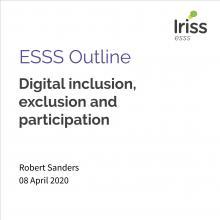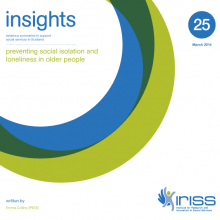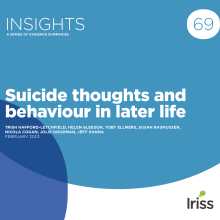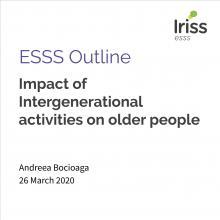Background
A draft strategy has been developed by the Scottish Government following the last Scottish Parliament's Equal Opportunities Committee Inquiry into Age and Social Isolation. The Scottish Government (2018) reports that the draft Strategy seeks to:
- Articulate a vision of the kind of Scotland we want to see, where community connections are increased and no one is excluded from participating in society for any reason
- Define what we understand concepts of social isolation and loneliness to be, and the degree to which they are prevalent in Scotland today
- Highlight what we've heard so far in our process of engaging with stakeholders throughout the development of the draft Strategy
- Set out how we want to empower communities to lead efforts to tackle social isolation and loneliness, in the context of our approach to community empowerment
- Highlight the Government's own work in this area and clearly link this to the broader policy context in which we're operating
- Facilitate discussion amongst organisations and individuals about what needs to be done to effectively tackle social isolation and loneliness in Scotland
This literature search was commissioned by an alliance of older people's forums to contribute to the evidence base for their report feeding into the Scottish Government's strategy. It is not systematic or comprehensive but instead aims to provide links to perspectives from academic research that may be less commonly present within contributions to consultations. The majority of articles are systematic reviews and literature reviews.
Older people and loneliness
Definitions
In the context of the Scottish Government (2018) consultation:
Social isolation refers to the quality and quantity of the social relationships a person has at individual, group, community and societal levels.
Loneliness is a subjective feeling experienced when there is a difference between an individual's felt and ideal levels of social relationships.
These definitions informed the search strategy and inclusion and exclusion of results.
Community context
Bernard, SM and Perry, H (2013) Loneliness and social isolation among older people in North Yorkshire: Stage 2 report. Research Report. SPRU Working Paper, WP 259. Social Policy Research Unit (pdf)
Abstract
There has been a growing interest in the topic of loneliness and social isolation over a number of years and a recognition that they have an impact on the health and wellbeing of individuals and communities. Local strategic organisations have an important role to play in tackling the problem of loneliness and social isolation in older people. The research aimed to identify the range of statutory and third sector organisations in North Yorkshire that could or should be able to identify older people at risk of loneliness and/or social isolation. Through these organisations, the sorts of activities that exist across North Yorkshire and some of their characteristics were described.
Buffel, T et al. (2015) Social isolation among older people in urban areas: a review of the literature for the Ambition for Ageing programme in Greater Manchester (pdf)
The aim of this booklet is to review what we know about the characteristics and causes of social isolation, the groups who are most at risk, the value of encouraging social participation, and evidence about the most effective forms of intervention.
Dury, R (2014) Social isolation and loneliness in the elderly: an exploration of some of the issues. British Journal of Community Nursing, 19(3), pp.125-128 (paywalled)
Older people are more vulnerable to loneliness and social isolation, and are more at risk of a range of health and social issues which can be directly linked to loneliness. However, there are often complex problems which are unique to the older age group which can have a profound effect on the provision and budgets of both health and social care. Various schemes have been put in place across the country to try to reduce the effects of loneliness and there is some evidence to support the mentoring and befriending models, although more research would provide clarity regarding their effectiveness.
Heylen, L (2010) The older, the lonelier? risk factors for social loneliness in old age. Ageing and Society, 30(7), pp.1177-1196 (paywalled)
Loneliness is often associated with old age, but many studies have shown that the relationship is not straightforward. This paper seeks a better understanding of the impact of social isolation on feelings of loneliness among older people, by building on the theoretical and actual distinction between social and emotional loneliness. Social loneliness refers to a lack of feelings of social integration; emotional loneliness emerges in the absence of an attachment figure. This paper focuses on social loneliness and has two aims, first to disentangle the direct and intermediate effects of both the number and the quality of social relationships on social loneliness in old age, and second to detect the groups at risk of social loneliness by identifying which personal features correspond with which relational deficits and therefore indirectly increase the risk on social loneliness. Data are analyzed for a sample of 1,414 respondents aged 55 or more years drawn from the Panel Study of Belgian Households conducted in 2000. The results confirm that improved understanding is gained by decomposing the interrelation between age and other background features, on the one hand, and the social relational features, on the other, as indirect and direct predictors of social loneliness. Generally, this approach promotes a correct identification of the groups at risk of social loneliness in old age.
Malzer, S (2014) A report on barriers to accessing health and social care services for older people from black and minority ethnic backgrounds in South Glasgow (pdf)
From executive summary
This report explores barriers to accessing health and social care services for older people from visible ethnic minority backgrounds living in the south of Glasgow.
A key finding from this comparison shows that the level of awareness of services among older people from BME communities is low and appears to have barely changed in 25 years. The present study found that older people maintained that they did not know how to go about accessing social services and lamented a general lack of information about services, often relying on intermediary organisations like day centres, or word of mouth from others, to gather information they wanted about services.
Another seemingly intransigent issue is the perception among older people from ethnic minorities that the services on offer to them have very little cultural congruence with their own lives. Not only do people think they will not be understood through basic communication difficulties, they also feel there is very little sensitivity within services to other cultural norms such as religious observance, food consumption differences and even correct pronunciation of names.
One obvious measure to counter this trend has been the appointment of people from the ethnic minorities themselves in key roles within the services on offer. This study found no evidence of people from ethnic minorities working in key roles in social services, or their mainstream satellite agencies, in the south of Glasgow, despite suggestions in the literature that various attempts have been made to introduce this measure within Glasgow City Council and its predecessor with social service responsibility, Strathclyde Regional Council.
Research around interventions
Franck, L et al. (2016) Systematic review of interventions addressing social isolation and depression in aged care clients. Quality of Life Research, 25(6), pp.1395–1407 (paywalled or author copy)
Objective: A systematic review was undertaken of studies reporting interventions for reducing social isolation and depression in older people receiving aged care services (community or residential).
Methods: Gray literature and relevant electronic databases were systematically searched for studies published in English between January 2009 and December 2013. Two reviewers independently screened studies for selection using predetermined inclusion and exclusion criteria and independently completed methodological quality review at study level. Studies of poor methodological quality were excluded. Data were extracted at study level by one reviewer and independently checked by a second reviewer, using a standardized form. The results across studies were qualitatively synthesized with outcomes described and summarized at last follow-up.
Results: Although the original objective was to review rural studies, no intervention studies based in rural areas met criteria for inclusion in the review, and only urban studies could be reviewed. Of 403 articles, six articles representing five studies with moderate-to-low risk of bias were included for review. All study participants were older adults ranging in age from 77 to 86 years. All studies had small sample sizes, ranging from 26 to 113 participants. Three of the five included intervention studies successfully reduced social isolation; one also successfully reduced depression.
Conclusions: Only one intervention, group-based reminiscence therapy, was reported as successful in reducing both social isolation and depression in older people within an urban aged care setting. More research is needed to explore transferability of interventions across different aged care settings and into rural areas.
Gardiner, C et al. (2018) Interventions to reduce social isolation and loneliness among older people: an integrative review. Health and Social Care in the Community, 26(2), 2018, pp.147-157 (open access)
Loneliness and social isolation are major problems for older adults. Interventions and activities aimed at reducing social isolation and loneliness are widely advocated as a solution to this growing problem. The aim of this study was to conduct an integrative review to identify the range and scope of interventions that target social isolation and loneliness among older people, to gain insight into why interventions are successful and to determine the effectiveness of those interventions. Six electronic databases were searched from 2003 until January 2016 for literature relating to interventions with a primary or secondary outcome of reducing or preventing social isolation and/or loneliness among older people. Data evaluation followed Evidence for Policy and Practice Information and Co‐ordinating Centre guidelines and data analysis was conducted using a descriptive thematic method for synthesising data. The review identified 38 studies. A range of interventions were described which relied on differing mechanisms for reducing social isolation and loneliness. The majority of interventions reported some success in reducing social isolation and loneliness, but the quality of evidence was generally weak. Factors which were associated with the most effective interventions included adaptability, a community development approach, and productive engagement. A wide range of interventions have been developed to tackle social isolation and loneliness among older people. However, the quality of the evidence base is weak and further research is required to provide more robust data on the effectiveness of interventions. Furthermore, there is an urgent need to further develop theoretical understandings of how successful interventions mediate social isolation and loneliness.
Hagan, R et al. (2014) Reducing loneliness amongst older people: a systematic search and narrative review. Aging and Mental Health, 18(6), 2014, pp.683-693 (paywalled or preprint)
Objective: To investigate the effectiveness of recent social therapeutic interventions to reduce loneliness in older people. Method: To examine this matter, a literature review, using seven databases, was undertaken using search terms relating to the themes of ageing, loneliness and social support. A total of 17 relevant studies relating to loneliness interventions were analysed. Results: Three studies reporting on new technologies and one on a group work intervention identified significant reductions in loneliness. Conclusion: Further research into interventions using new technologies to reduce loneliness in older people is recommended.
Healthy Ageing in Scotland research project, University of Stirling (website)
Healthy Ageing In Scotland (HAGIS) is a study of people aged 50+ in Scotland. It collects data on their economic and social circumstances and on their health. Its goal is to help improve the lives of older Scots by increasing understanding the stresses, strains and successes of their lives, and so ensure that policy meets their needs.
HAGIS is the first Scottish study to follow older people over time - the intention is to re-interview members of the study at intervals of two years.
HAGIS is also part of the world family of ageing studies which track older peoples' circumstances through time. The initiative to develop these studies and bring them together came from the National Institute of Aging, which is an agency of the US federal government. Together, the studies now cover more than half the world's population aged 50+. By bringing them together, it is possible to compare the lives of older Scots with those of older people in, for example, the USA, Mexico, Finland and India.
Aspects of the project include loneliness and isolation. Pilot results of initial research will be published in forthcoming weeks.
Stojanovic, J et al. (2017) Decreasing loneliness and social isolation among the older people: systematic search and narrative review. Epidemiology Biostatistics and Public Health, 14(2), e12408-1-e12408-8 (open access)
Introduction: The aim of this study is to sum up the current knowledge on the effectiveness of the existing interventions for alleviating loneliness and social isolation among elderly persons.
Methods: We used a systematic approach and performed a literature search of MEDLINE, ISI Web of science, SCOPUS, The Cochrane Library, and CINAHL databases. After identifying 13 eligible reviews addressing interventions of our interest, we proceeded with a narrative description of the study findings.
Results: The initiatives largely encompassed one-to-one interventions, group activities or community engagement approaches. In particular, technology interventions were recently given much attention. Overall, the studies showed non-satisfying methodological quality and their results were often inconclusive.
Conclusions: Although there is a growing body of evidence referring to implementation of interventions targeting social isolation and loneliness among the elderly, future well-designed interventions are necessary in order to draw firm conclusions.
Social capital
Coll-Planas, L et al. (2017) Social capital interventions targeting older people and their impact on health: a systematic review. Journal of Epidemiology & Community Health, 71(7), pp.663-672 (paywalled)
Background: Observational studies show that social capital is a protective health factor. Therefore, we aim to assess the currently unclear health impact of social capital interventions targeting older adults.
Methods: We conducted a systematic review based on a logic model. Studies published between January 1980 and July 2015 were retrieved from MEDLINE, EMBASE, CINAHL, PsycINFO, Cochrane Central Register of Controlled Trials and Web of Science. We included randomised controlled trials targeting participants over 60 years old and focused on social capital or its components (eg, social support and social participation). The comparison group should not promote social capital. We assessed risk of bias and impact on health outcomes and use of health-related resources applying a procedure from the Canadian Agency for Drugs and Technologies in Health (CADTH) based on vote-counting and standardised decision rules. The review protocol was registered in PROSPERO (reference number CRD42014015362).
Results: We examined 17 341 abstracts and included 73 papers reporting 36 trials. Trials were clinically and methodologically diverse and reported positive effects in different contexts, populations and interventions across multiple subjective and objective measures. According to sufficiently reported outcomes, social capital interventions showed mixed effects on quality of life, well-being and self-perceived health and were generally ineffective on loneliness, mood and mortality. Eight trials with high quality showed favourable impacts on overall, mental and physical health, mortality and use of health-related resources.
Conclusions: Our review highlights the lack of evidence and the diversity among trials, while supporting the potential of social capital interventions to reach comprehensive health effects in older adults.
Nyqvist, F et al. (2013) Social capital as a resource for mental well-being in older people: a systematic review. Aging and Mental Health, 17(4), pp.394-410 (paywalled)
Social capital has previously been reviewed in relation to mental health. However, none have focused specifically on positive aspects of mental health such as mental well-being. This systematic review aimed to explore the relationship between social capital and mental well-being in older people. Ten relevant databases were systematically searched using an extensive search strategy for studies, analyzing the link between social capital and mental well-being. Criteria for inclusion in the systematic review were: the study sample included older people (≥50 years); the study reported a mental well-being outcome; social capital was an exposure variable; and empirical research using quantitative methods and published in English, between January 1990 and September 2011. Eleven studies met the inclusion criteria. Each study was assessed against seven possible exposure measures (structural, cognitive; bonding, bridging, linking; individual, collective). The results showed that all included studies found positive associations between parts of social capital and aspects of mental well-being. Typically, the relationship between social capital and mental well-being differed within as well as between studies. The results highlight that there is no 'gold standard' of how to measure social capital or mental well-being. Social capital is generated in the interaction between individual and collective life. A possibility for future research is therefore to follow Bronfenbrenner's classical division into macro, meso, and micro levels. The authors consider family and friends at the micro level to be the key factors in generating social capital and well-being in older people.
Mental wellbeing
Mann, F et al. (2017) A life less lonely: the state of the art in interventions to reduce loneliness in people with mental health problems (open access)
Purpose: There is growing evidence of significant harmful effects of loneliness. Relatively little work has focused on how best to reduce loneliness in people with mental health problems. We aim to present an overview of the current state of the art in loneliness interventions in people with mental health problems, identify relevant challenges, and highlight priorities for future research and implementation.
Methods: A scoping review of the published and grey literature was conducted, as well as discussions with relevant experts, to propose a broad classification system for types of interventions targeting loneliness.
Results: We categorised interventions as 'direct', targeting loneliness and related concepts in social relationships, and 'indirect' broader approaches to well-being that may impact on loneliness. We describe four broad groups of direct interventions: changing cognitions; social skills training and psychoeducation; supported socialisation or having a 'socially-focused supporter'; and 'wider community approaches'. The most promising emerging evidence appears to be in 'changing cognitions', but, as yet, no approaches have a robust evidence base. Challenges include who is best placed to offer the intervention, how to test such complex interventions, and the stigma surrounding loneliness.
Conclusions: Development of clearly defined loneliness interventions, high-quality trials of effectiveness, and identifying which approaches work best for whom is required. Promising future approaches may include wider community initiatives and social prescribing. It is important to place loneliness and social relationships high on the wider public mental health and research agenda.
Mountain, G et al. (2017) A preventative lifestyle intervention for older adults (lifestyle matters): a randomised controlled trial. Age and Ageing, 4(1), pp. 627-634 (open access)
Objectives: to test whether an occupation-based lifestyle intervention can sustain and improve the mental well-being of adults aged 65 years or over compared to usual care, using an individually randomised controlled trial.
Participants: 288 independently living adults aged 65 years or over, with normal cognition, were recruited from two UK sites between December 2011 and November 2015.
Interventions: lifestyle Matters is a National Institute for Health and Care Excellence recommended multi-component preventive intervention designed to improve the mental well-being of community living older people at risk of decline. It involves weekly group sessions over 4 months and one to one sessions.
Main outcome measures: the primary outcome was mental well-being at 6 months (mental health (MH) dimension of the SF-36). Secondary outcomes included physical health dimensions of the SF-36, extent of depression (PHQ-9), quality of life (EQ-5D) and loneliness (de Jong Gierveld Loneliness Scale), assessed at 6 and 24 months.
Results: data on 262 (intervention = 136; usual care = 126) participants were analysed using intention to treat analysis. Mean SF-36 MH scores at 6 months differed by 2.3 points (95 CI: -1.3 to 5.9; P = 0.209) after adjustments.
Conclusions: analysis shows little evidence of clinical or cost-effectiveness in the recruited population with analysis of the primary outcome revealing that the study participants were mentally well at baseline. The results pose questions regarding how preventive interventions to promote well-being in older adults can be effectively targeted in the absence of proactive mechanisms to identify those who at risk of decline.
Mobility and wellbeing
Bevan, MA et al. (2017) Co-Motion: Mobility and wellbeing in later life.
Summary of key findings and recommendations. York: University of York (pdf)
This report summarises the main findings and conclusions of the Co-Motion project. Working with older people, this project aimed to explore a range of options and tools that may be able to meet contrasting needs, support mobility and wellbeing, and do so more quickly and affordably than adapting the built environment. The specific aims of the project were to:
- Explore mobility and wellbeing for older people going through critical but common life transitions;
- Investigate and address variation and contradictions in the needs of different groups of older people (and even for single individuals over time), and between different built environment agendas; and
- To co-create practical tools that can act as complements or alternatives to the redesign of the built environment.
Social inclusion and community-building
Ronzi, S et al. (2018) What is the impact on health and wellbeing of interventions that foster respect and social inclusion in community-residing older adults? A systematic review of quantitative and qualitative studies. BMC Systematic Reviews, 87(26) (open access)
Background: Many interventions have been developed to promote respect and social inclusion among older people, but the evidence on their impacts on health has not been synthesised. This systematic review aims to appraise the state of the evidence across the quantitative and qualitative literature.
Methods: Eligible studies published between 1990 and 2015 were identified by scanning seven bibliographic databases using a pre-piloted strategy, searching grey literature and contacting experts. Studies were included if they assessed the impact (quantitatively) and/or perceived impact (qualitatively) of an intervention promoting respect and social inclusion on the physical or mental health of community-residing people aged 60 years and older. Titles and abstracts were screened for eligibility by one reviewer. A second reviewer independently screened a 10% random sample. Full texts were screened for eligibility by one reviewer, with verification by another reviewer. Risk of bias was assessed using standardised tools. Findings were summarised using narrative synthesis, harvest plots and logic models to depict the potential pathways to health outcomes.
Results: Of the 27,354 records retrieved, 40 studies (23 quantitative, 6 qualitative, 11 mixed methods) were included. All studies were conducted in high and upper middle-income countries. Interventions involved mentoring, intergenerational and multi-activity programmes, dancing, music and singing, art and culture and information-communication technology. Most studies (n = 24) were at high or moderate risk of bias. Music and singing, intergenerational interventions, art and culture and multi-activity interventions were associated with an overall positive impact on health outcomes. This included depression (n = 3), wellbeing (n = 3), subjective health (n = 2), quality of life (n = 2), perceived stress and mental health (n = 2) and physical health (n = 2). Qualitative studies offered explanations for mediating factors (e.g. improved self-esteem) that may lead to improved health outcomes and contributed to the assessment of causation.
Conclusions: Whilst this review suggests that some interventions may positively impact on the health outcomes of older people, and identified mediating factors to health outcomes, the evidence is based on studies with heterogeneous methodologies. Many of the interventions were delivered as projects to selected groups, raising important questions about the feasibility of wider implementation and the potential for population-wide benefits.
Digital engagement
Chen, Y.-R. R., & Schulz, P. J. (2016). The effect of information communication technology interventions on reducing social isolation in the elderly: a systematic review. Journal of Medical Internet Research, 18(1), e18 (open access)
Background: The aging of the population is an inexorable change that challenges governments and societies in every developed country. Based on clinical and empirical data, social isolation is found to be prevalent among elderly people, and it has negative consequences on the elderly's psychological and physical health. Targeting social isolation has become a focus area for policy and practice. Evidence indicates that contemporary information and communication technologies (ICT) have the potential to prevent or reduce the social isolation of elderly people via various mechanisms.
Objective: This systematic review explored the effects of ICT interventions on reducing social isolation of the elderly.
Methods: Relevant electronic databases (PsycINFO, PubMed, MEDLINE, EBSCO, SSCI, Communication Studies: a SAGE Full-Text Collection, Communication & Mass Media Complete, Association for Computing Machinery (ACM) Digital Library, and IEEE Xplore) were systematically searched using a unified strategy to identify quantitative and qualitative studies on the effectiveness of ICT-mediated social isolation interventions for elderly people published in English between 2002 and 2015. Narrative synthesis was performed to interpret the results of the identified studies, and their quality was also appraised.
Results: Twenty-five publications were included in the review. Four of them were evaluated as rigorous research. Most studies measured the effectiveness of ICT by measuring specific dimensions rather than social isolation in general. ICT use was consistently found to affect social support, social connectedness, and social isolation in general positively. The results for loneliness were inconclusive. Even though most were positive, some studies found a nonsignificant or negative impact. More importantly, the positive effect of ICT use on social connectedness and social support seemed to be short-term and did not last for more than six months after the intervention. The results for self-esteem and control over one's life were consistent but generally nonsignificant. ICT was found to alleviate the elderly's social isolation through four mechanisms: connecting to the outside world, gaining social support, engaging in activities of interests, and boosting self-confidence.
Conclusions: More well-designed studies that contain a minimum risk of research bias are needed to draw conclusions on the effectiveness of ICT interventions for elderly people in reducing their perceived social isolation as a multidimensional concept. The results of this review suggest that ICT could be an effective tool to tackle social isolation among the elderly. However, it is not suitable for every senior alike. Future research should identify who among elderly people can most benefit from ICT use in reducing social isolation. Research on other types of ICT (eg, mobile phone–based instant messaging apps) should be conducted to promote understanding and practice of ICT-based social-isolation interventions for elderly people.
Chipps, J et al. (2017) The effectiveness of e-interventions on reducing social isolation in older persons: a systematic review of systematic reviews. Journal of Telemedicine and Telecare, 23(10), pp.817-827 (paywalled)
As the older adult population group has been increasing in size, there has been evidence of growing social isolation and loneliness in their lives. The increased use of information communication technology and Internet-supported interventions has stimulated an interest in the benefits of e-Interventions for older people and specifically in having a role in increasing social networks and decreasing loneliness. A systematic review of e-Interventions to reduce loneliness in older people was conducted with the aim to synthesize high quality evidence on the effectiveness of e-Interventions to decrease social isolation/loneliness for older people living in community/residential care. A systematic search of 12 databases for reviews published between 2000–2017 was conducted using search term synonyms for older people, social isolation and interventions. Three independent researchers screened articles and two reviewers extracted data. The Revised-Assessment of Multiple Systematic Reviews was used to assess the quality of reviews. The final search identified 12 reviews, which included 22 unique primary research studies evaluating e-Interventions for social isolation or loneliness. The reviews were of moderate quality and the primary studies showed a lack of rigor. Loneliness was most frequently measured using the University California Los Angeles Loneliness Scale. Despite the limitations of the reviewed studies, there is inconsistent and weak evidence on using e-Interventions for loneliness in older people.
Damant, J et al. (2016) Effects of digital engagement on the quality of life of older people. Health & Social Care in the Community (open access)
It is often asserted that older people's quality of life (QOL) is improved when they adopt information and communication technology (ICT) such as the Internet, mobile phones and computers. Similar assumptions are made about older people's use of ICT-based care such as telecare and telehealth. To examine the evidence around these claims, we conducted a scoping review of the academic and grey literature, covering the period between January 2007 and August 2014. A framework analysis approach, based on six domains of QOL derived from the ASCOT and WHOQOL models, was adopted to deductively code and analyse relevant literature.
The review revealed mixed results. Older people's use of ICT in both mainstream and care contexts has been shown to have both positive and negative impacts on several aspects of QOL. Studies which have rigorously assessed the impact of older people's use of ICT on their QOL mostly demonstrate little effect. A number of qualitative studies have reported on the positive effects for older people who use ICT such as email or Skype to keep in touch with family and friends. Overall, the review unearthed several inconsistencies around the effects of older people's ICT use on their QOL, suggesting that implicit agreement is needed on the best research methods and instrumentation to adequately describe older people's experiences in today's digital age. Moreover, the available evidence does not consider the large number of older people who do not use ICT and how non-use affects QOL.
Gow, AJ et al. (2013) Which social network or support factors are associated with cognitive abilities in old age? Gerontology, 59(5), pp.454-463 (paywalled or author copy)
Background: Social networks and support have been proposed as cognitively protective in old age. As studies often consider these social factors in isolation the question of which characteristics of the social environment are beneficial remains. Objective: The current study examined associations between measures of social networks (including contact with friends/family, marital status and living arrangement), feelings of loneliness and social support, and a range of cognitive outcomes.
Methods: Social network, loneliness and support data were available in the Lothian Birth Cohort 1936 (LBC1936, n = 1,091) at age 70. Participants completed a battery of cognitive tests, and factor scores were available for general cognitive ability, and the cognitive domains of processing speed and memory. Childhood cognitive ability data from age 11 were also available.
Results: When examined in separate ANCOVAs, lower loneliness and more social support were significantly associated with better cognitive abilities at age 70, though not memory (independently of age, sex, childhood cognitive ability and social class), accounting for about 0.5-1.5% of the variance. When the social factors were considered simultaneously, higher loneliness remained associated with lower general cognitive ability (ηp2 = 0.005, p = 0.046), and those living alone (ηp2 = 0.007, p = 0.014) or with less social support (ηp2 = 0.007, p = 0.016) had slower processing speed. When these final models were repeated including a depression symptoms score as a covariate, the associations between loneliness and general cognitive ability, and social support and processing speed, were no longer significant. However, the association between living alone and processing speed remained (ηp2 = 0.006, p = 0.031).
Conclusions: Of the social factors considered, loneliness, social support and living arrangement were most consistently associated with aspects of cognitive ability in older people, and these associations appeared to be partly, though not wholly, accounted for by symptoms of depression. Although longitudinal follow-up is required to examine the causal direction of the effects more definitively, it may be beneficial to promote the development of interventions to reduce loneliness and social isolation, and to increase social support.
Myhre, JW et al. (2017) Cognitive benefits of online social networking for healthy older adults. The Journals of Gerontology Series B: Psychological Sciences and Social Sciences, 72(5), pp.752–760 (open access)
Objectives: Research suggests that older adults who remain socially active and cognitively engaged have better cognitive function than those who are isolated and disengaged. This study examined the efficacy of learning and using an online social networking website, Facebook.com, as an intervention to maintain or enhance cognitive function in older adults.
Method: Forty-one older adults were assigned to learn and use Facebook (n = 14) or an online diary website (active control, n = 13) for 8 weeks or placed on a waitlist (n = 14). Outcome measures included neuropsychological tests of executive functions, memory, and processing speed and self-report questionnaires about social engagement.
Results: The Facebook group showed a significant increase in a composite measure of updating, an executive function factor associated with complex working memory tasks, compared to no significant change in the control groups. Other measures of cognitive function and social support showed no differential improvement in the Facebook group.
Discussion: Learning and using an online social networking site may provide specific benefits for complex working memory in a group of healthy older adults. This may reflect the particular cognitive demands associated with online social networking and/or the benefits of social engagement more generally.
Evaluation of interventions
Jongen, W et al. (2013) Evaluating interventions aimed at promoting social participation of older people: a review of the literature. Albanian Medical Journal, 1(1), pp.55-61 (open access)
As a reaction to the growing amount of academic literature on the relationship between social participation and health outcomes such as quality of life, this article intends to explain how the effectiveness of interventions aimed at promoting social participation of older people can be evaluated, in order to identify good practices which are relevant for Europe. In doing so, this article ass and the health of older people. Following a model for evaluating evidence on the effectiveness of health promotion interventions, this article analyses three systematic reviews for answering the above-mentioned research question. In general, group interventions with a strong interactive character, having an educational input or offering social support, targeted at specific groups of older people and including the older people in the development and implementation of the interventions, were considered as the most effective type of interventions. The systematic reviews analysed in this article, however, suffer from several serious weaknesses, concerning credibility of the research itself, completeness of the evaluated intervention outcomes, and transferability of the research evidence. Future research should be directed to more specific types of interventions promoting social participation and specifically to European interventions.
Tools and resources
Moffat, V et al. (2018) Plan for prevention - prompt cards: preventing loneliness and social isolation for older people. Iriss (website and pdf)
These cards are reminders to think about ways people in social services, care and support can work with people you support to help them keep connected. For example social isolation and loneliness are associated with poorer health and well-being. These cards prompt people to think about preventative approaches to maintain and build social and community connections for older people. The anticipated outcome of using this tool is that are that people are supported to talk about loneliness.







